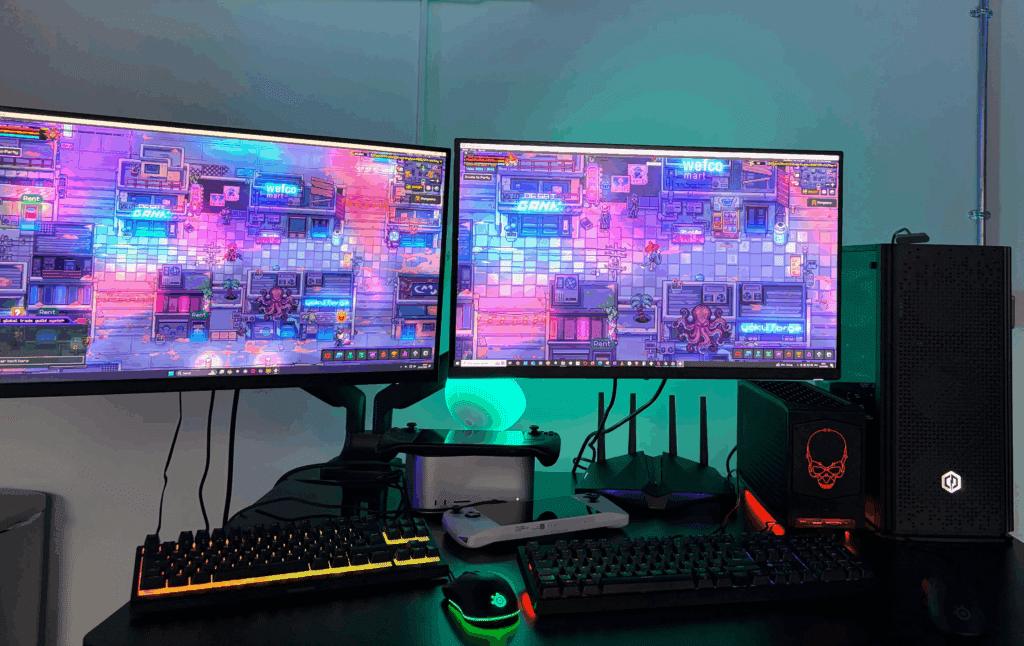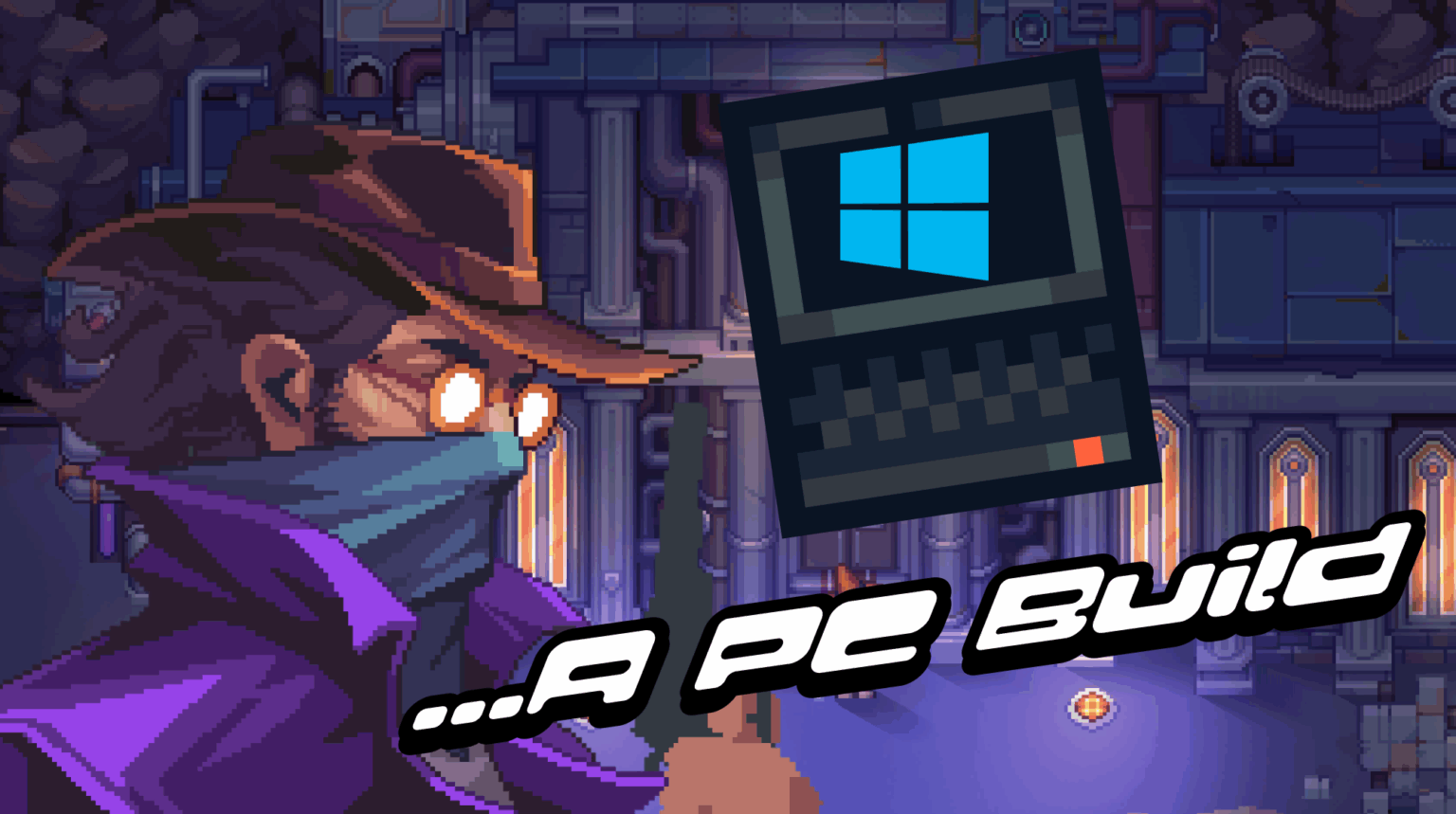tl;dr
We have built a cross-platform destop client allowing you to play Soulbound at 200fps+ if your monitor will handle it. We’re inviting all players to test this experimental build knowing that the following features are currently known to be failing:
- Cosmetic Store
- Guild UI
- PixelBay (Auction House)
- Sound and audio
Download the PC Early Access Build Here
We heard you, we need a PC build
When we started building Soulbound we launched on the browser platform to make it instantly accessible. No downloads, no platforms just jump in and play. Over the past three years we’ve pushed that technology to the limits, achieving 120fps gaming experience on many setups (M series macs especially). But despite the advancements, becoming the first MMO on Discord and all the bug reports and feedback from players, we’ve not been able to deliverthe level of smoothness and stability the community deserves.
Players asked again and again for a native PC build, or at least a way to boost FPS.
The message was clear: too many were struggling with poor performance and unstable connections, especially during bosses and high-tier dungeons.bnjmn
So, we asked ourselves: What if Soulbound could take full advantage of your CPU and GPU and wasn’t limited by the chromium browser engine?
We suspected that a PC client would run faster, but we had a bigger suspicion that compiling the game into native C++ instead of using a virtual runner, or javascript, would magically solve many of the year long issues we’ve been tackling with our engine.
We made the decision to investigate our suspicions, kicking off one of the biggest projects to date. It would require an update to the engine runtime, rewriting many game functions, and in some cases, working closely with the engine team to fix issues as they emerge. It’s a deep, highly technical process that takes months, requiring our engineers to debug at a much lower programming level in the engine than ever before.
To quote our CTO.

Benchmarking the build
To test our theory, we benchmarked each new build across three machines:

Machine A – NUC12DCMi7 (i7-12700 + RTX 3060 Ti, 32 GB RAM)
- CPU: Intel i7-12700 (12th gen Alder Lake, 12C/20T).
- GPU: RTX 3060 Ti
- RAM: 32 GB
Machine B – i5-10400F + GTX 1650, 16 GB RAM
- CPU: Intel i5-10400F (10th gen Comet Lake, 6C/12T).
- GPU: GTX 1650
- RAM: 16 GB
Machine C(Handheld) – Ryzen Z1 Extreme + RDNA3 iGPU, 16 GB RAM
- CPU: AMD Ryzen Z1 Extreme
- GPU: Integrated RDNA3 graphics (12 CUs, ~2.7 TFLOPs)
- RAM: 16 GB LPDDR5
The results from the first native C++ build were immediately very promising.
Due to how we record screens on these benchmark machines, the framerate and quality may dip as they are remotely streamed.
100 Mob Cap Dungeon Test
Machine A was pushing 200+ fps in Farpoint Extreme with no frame or lag spikes and the overall experience felt smoother.
machine B sat well above 87fps, similarly, a lot smoother.
We then stress-tested 10-player raids with over 50 mobs on screen, the game felt the same as having 10 enemies. To our surprise, even at 30 FPS the experience felt smoother than 120 FPS in the browser build.
We concluded that this was due to a smoother, more predictable frametime which made the game feel more predictable and responsive.
During our testing, the QA team felt that the game had become more responsive to inputs. UI was faster, smoother and more responsive. The apartment builder felt snappy and enjoyable to use.
This uncovered an input lag arising from the browser build of the game. It wasn’t small either, with key inputs on browser incurring a massive latency hit for reasons we cannot explain.
For those that have cleared Farpoint Extreme, you may be familiar with rubber banding once the stage reaches higher levels. On the native C++ build, we found that this issue was even more noticeable. Once we pushed beyond 5 players, we experienced severe rubber banding. In the past we believed this to be the result of server bottlenecks, however on inspection our team uncovered that the issue was the client side networking code we had developed to process the server data on the game client. We decided to spend weeks developing a new networking extension in C++ to give the PC build the best chance it had at showing us what was possible on the platform.
The first demo was eye opening. We were able to run a larger, explorative dungeon mode that had hundredsof enemies on screen and 3 party members, with no visible rubberbanding or lag at all. It was so good, it felt like a different game entirely.
In previous builds of the dungeons, we ran longer, roomless environments , but performance issues forced us to move players through rooms as it madeclear the unknown issues around performance degradation in longer sessions. To evalutate, we built a one player dungeon demo using 100s of mobs swarming for 30 minutes, and found no degradation in performance over time. Some of the QA team had dungeons running for over 3 hours, at a solid 60+FPS on machine B.
We believe Soulbound has the potential to reach millions of players worldwide and support 100,000+ concurrent users. These developments show that a native PC client would make the game accessible to far more players and solve many of the pain points the community has experienced.
Mac and iOS
For the Mac users, while we think existing networking will suffice in the interim, we plan to explore developing new networking functions to enhance the experience for Mac users long term. Additionally, this new runtime enables us to create a native iOS build. Although this build isn’t yet ready for distribution, we expect that this will become a more realistic roadmap objective once we have a native PC client.
Give us your feedback
We wanted to share this update early and get your thoughts before finalizing our roadmap. We expect the first PC client to be ready for community testing in the coming weeks and soon after, we’ll reveal the huge upgrades to abilities, gear, and dungeon systems that build on this new foundation.
We’d love your feedback on this direction. A native PC client would let us design around high-performance gameplay, but it may mean the browser version becomes less of a priority.
👉 Should we keep investing in the browser build, or focus fully on a native PC experience?
Join the discussion in Discord and let us know what you’d like us to work on next in our #share-feedback channel: https://discord.gg/UbEZvCg2Dc
We’re extremely excited to see what you think of Soulbound when taking advantage of your machines CPU and GPU to the full potential.
